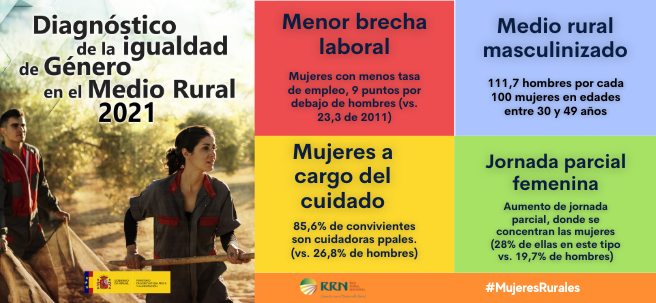
18 de July de 2022
The report updates the first study of its kind, conducted in 2011, which aims to understand the extent of gender inequality in rural areas.
- In the last ten years, the female employment rate has increased from 49% to 51.6%, and women are gaining ground in permanent contracts, rising from 36.7% of permanent contracts to 42.3%.
- The results of this diagnosis, which updates the first one carried out in 2011, show that gender inequalities in rural areas persist and that there is still work to be done to achieve real equality between women and men in rural areas.
The Ministry of Agriculture, Fisheries and Food presents the "2021 Gender Equality Assessment in Rural Areas"
On July 15, the Minister of Agriculture, Fisheries, and Food, Luis Planas, presented the report "Diagnosis of Gender Equality in Rural Areas 2021 ," prepared by the Ministry of Agriculture, Fisheries, and Food. This update of the first study of its kind, conducted in 2011, aims to understand the extent of gender inequality in rural areas. Minister Planas emphasized that, in order to implement effective policies to support and develop women in rural areas, it is essential to better understand their current situation and how it has changed over the last decade.
On the positive side, it's worth noting that the female employment rate has increased from 49% to 51.6%. Furthermore, women are gaining ground in permanent contracts, rising from 36.7% of permanent contracts to 42.3% . These figures show progress in terms of their incorporation into the workforce, with improvements also in their working conditions.
The study identifies the factors that influence gender inequalities and is structured into five chapters:
- The sociodemographic situation in rural areas
- The labor market
- The uses of time
- The perception of quality of life in rural areas
- The validity of gender stereotypes and roles in rural society
Within each of them, the information is analyzed according to the age of the individuals and the size of the municipalities where they reside.
Sociodemographic situation in rural areas
Rural communities experience high rates of population aging , declining birth rates , and a male- dominated working age group because the rural exodus is predominantly female. In these areas, there are 111.7 men for every 100 women between the ages of 30 and 49, according to data from the National Institute of Statistics (INE) for 2021.
Labor market
In the labor market, the female employment rate is lower than that of men (51.6% and 60.6%, respectively). Compared to 2011, there has been a significant decrease in the gender employment gap (from 23.3 percentage points in 2011 to 9 points currently).
Regarding the diversification of the rural economy and employment, the services sector is the largest employer, accounting for 47.3% of the population, followed by the agricultural sector, which has gained in share, rising from 19.3% to 23.6%.
Horizontal and vertical segregation in the labor market continues, but to a lesser extent. The presence of women in management positions has increased slightly, from 16.2% to 19.6%; and in technical positions, from 18.9% to 25.6%. Women perform more unskilled jobs, specifically representing 21.2%. Furthermore, they hold the top positions in part-time jobs, 28% compared to 19.7% for men; and they hold salaried positions. Entrepreneurs are predominantly men, although the gap in this area has narrowed, with a slight increase in the number of female entrepreneurs.
The uses of time
An analysis of time use reveals that the differences between men and women are narrowing in leisure and free time activities, but they remain in other areas. Women are responsible for family and household care, while men continue to have a greater presence in the public sphere, specifically in social and political activities.
Perception of quality of life in rural areas
The perception of quality of life in rural areas shows figures similar to those recorded in 2011. This chapter reflects the need to increase the supply of services to meet their needs and improve the quality of life in these areas.
One of the main shortcomings is public transportation (nearly 4 out of 10 rural residents express dissatisfaction). Also, regarding care services for the elderly and dependents, 35.3% of those interviewed consider them insufficient, especially women who perform these tasks.
The validity of gender stereotypes and roles in rural society
The vast majority of them remain in poverty, which represents a significant obstacle to achieving gender equality. However, this report highlights that young people living in these areas are less conservative. This is encouraging evidence for building a more egalitarian society in the future.











